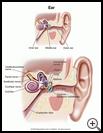
Ear Infection (Otitis Media): Teen Version
What is an ear infection?
An ear infection is an infection of the middle ear (the space behind the eardrum). It is often caused by bacteria. It usually is a complication of a cold and starts on the third day of the cold. A cold blocks off the eustachian tube (the passage connecting the middle ear to the back of the throat).
In 5% to 10% of ear infections, the pressure in the middle ear causes the eardrum to rupture and drain a yellow or cloudy fluid. This small tear usually heals over the next few days. Ear infections are uncommon after 10 years of age, but can occur in anyone. Permanent damage to the ear or to the hearing is very rare.
What are the symptoms?
Your ear is painful because trapped, infected fluid puts pressure on the eardrum, causing it to bulge. Other symptoms are irritability and poor sleep. You may have trouble hearing or be dizzy. If the eardrum ruptures (tears), cloudy fluid or pus will drain from the ear canal.
How can I take care of myself?
- Antibiotics (For mild ear infections, antibiotics may not be needed.)
You need the antibiotic prescribed by your healthcare provider. This medicine will kill the bacteria that are causing the ear infection.
Try not to forget any of the doses. Even though you will feel better in a few days, take the antibiotic until it is completely gone. Finishing the medicine will keep the ear infection from flaring up again.
- Pain relief
Acetaminophen or ibuprofen can be used to help with the earache or fever over 102° F (39° C) for a few days until the antibiotic takes effect. These medicines usually control the pain within 1 to 2 hours. Earaches tend to hurt more at bedtime.
To help ease the pain, you can put a cold pack or ice wrapped in a wet washcloth over the ear. This may decrease the swelling and pressure inside. Some healthcare providers recommend a heating pad or warm, moist washcloth instead. Remove the cold or heat in 20 minutes to prevent frostbite or a burn.
- Restrictions
Going outdoors is not a problem and you don't need to cover your ears. Swimming is fine as long as there is no perforation (tear) in the eardrum or drainage from the ear. You can travel safely by air if you are taking antibiotics. While coming down in elevation in an airplane or while in a car coming down from the mountains, swallow fluids or chew gum. You can return to school when you are feeling better and the fever is gone. Ear infections are not contagious.
- Ear recheck
See your healthcare provider in 2 to 3 weeks. At that visit, your eardrum will be checked to be certain that the infection is cleared up and no more treatment is needed. Your healthcare provider may also want to test your hearing. Follow-up exams are very important, particularly if the infection has caused a hole in the eardrum.
When should I call my healthcare provider?
Call IMMEDIATELY if:
- You develop a stiff neck.
- You feel very sick.
Call during office hours if:
- The fever or pain is not gone after you have taken the antibiotic for 48 hours.
- You have other questions or concerns.
Last modified: 2011-06-07
Last reviewed: 2011-06-06

